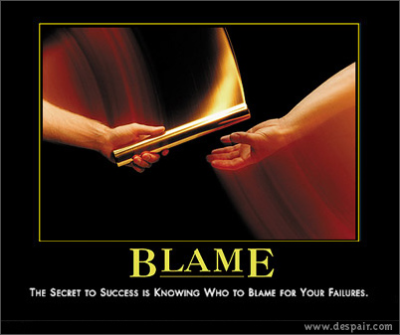Leadership Follies – Blamestorming

Are you Guilty of Blamestorming?
Blamestorming (n) (blām’stôr’mĭng) 1) A method of collectively finding one to blame for a mistake no one is willing to confess to. Often occurs in the form of a meeting of colleagues at work, gathered to decide who is to blame for a screw up.
What to do with Problems?
“We spend all of our time trying to figure out who or what is to blame and none of it trying to fix the problem,” said the senior leader. She was trying to figure out why the new “Focus on the Customer” strategy was not taking hold. I had seen it too often – a great idea or strategy to improve business performance that actually decreases it. Or organizations spend all their time looking for heads to roll. Here is a sample sentence used in a dictionary definition of the work “blamestorming:”
“The board of directors was exhausted after a four hour blamestorming session which finally resulted in two names for the chopping block.” ~ Gab Halasz,Merriam Webster
Why does this happen?
It is as if organizations are built on the principles of self preservation….wait, they are. Like any other organism, organizations actively work to survive. Unfortunately in business, sometimes survival is the enemy of exceptional or superior performance.
The major thrust of Jim Collin’s exceptional book “Good to Great” was the chasm between the good and the great. It is even showed recently.
The rash of companies that have failed in the past decade due to the “circling the wagon” mentality – Toyota, Goldman Sachs, BP and many more – or have lostmarket share because they can’t implement new strategies vital to their business’s success (think record labels dealing with the internet or US Steel Mills unable to deal with globalization). Clearly, there were efforts in all those companies to pull the organization towards a solution, but somehow it fell short.
It is almost understandable that a company would try to block or repel accusations of failure, but why would that happen internally? All the company’s departments are working towards the same goal, right?
“Anyone that has worked in a company with more than one person knows that eventually people lose sight of the common goal.” ~ Henry Ford
The Storm Clouds Gather
At some point in every employee’s career, they go from caring about the company to caring about themselves. Just like an individual, organizations start out focused, driven and building solutions for their customer’s success. But, companies can fall into the trap of caring more about their survival than the people orprocess that brought them success.
Chance of inclement weather and disaster
When companies reach the point that they do more “fixing the process” than solving customer problems, than blamestorming has taken over. It is easy to see when this happens:
Once a company starts to go down the blamestorming path, these are the things that can happen:
- Increase in internal bureaucracy
- Lower employee morale
- Decrease in new ideas coming from employees, lower organizational creativity
- Lots of CYB (cover your butt) action like documenting every single interaction
- Increase in Customer attrition
- Overall lower organizational efficiency
Riding the Storm Out
Blamestorming is an organizational issue, but it can be addressed at many layers within the organization.
At the team level
1) Focus on the problem and solve it.
Sounds simple, right? It is not as simple as it seems. The idea is that the long-term solution will come from solving the problem presented. Once the problem is solved completely take the solution and analyze it.
- Why did the solution work?
- How can it be used again?
- Where can we leverage this solution?
2) Don’t focus on the process, focus on the people
Process is important. It lends to organizational consistency, but once it is done for the sake of the process it is failing. This is evidenced when leaders want employees to follow process over action or impact. It is important that when solving a problem that individuals are taken into account. Make sure that the people are taken care of while solving the problem. All the people involved – customers, employees, vendors, etc. In the end people will make or break your process and the success of your company (just ask Jerry Reinsdorf how that went when Michael Jordan, Scottie Pippen, etc. left the Bulls.)
At the macro (organizational) level
1) Mine for Solutions
Organizations can foster a sense of pride and build creativity by promoting/highlighting solutions. This is not collecting best practices. Best practices have become “formulaic” and don’t allow for creativity. It is showcasing solutions. Promoting, as an organization, looking for and creating solutions.
2) Align to Strategy
This is going to sound a little bi-polar. On one hand, organizations need to promote a solution focus. That requires some freedom of thought and action where the primary objective is to solve organizational issues (customer problems, etc.) On the other hand there needs to be some focus on the focus. That is there needs to be some direction or boundaries to the problems being solved. Actions taken within the organization and to forward the organization should be taken towards a common end or strategy. This will increase the overall organizational effectiveness.
Why do something about it now?
A logical question might be, “Why should we worry about this now?” Organizations that don’t will go the way to horse carriage makers, US Watch makers, etc. These organizations did not see that they were not solving customer issues but holding on to a way to doing business or even product that wasn’t needed.


No comments:
Post a Comment